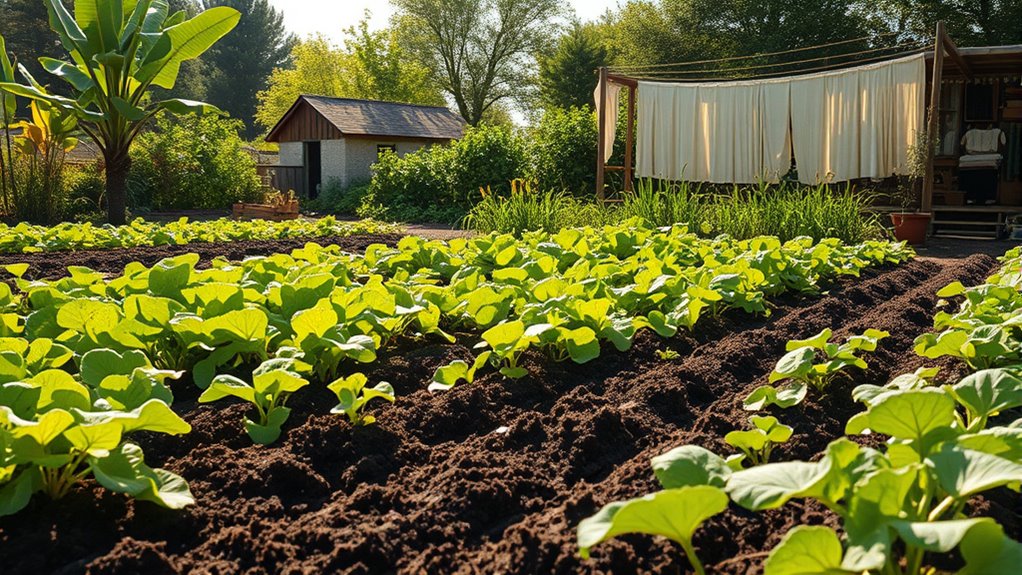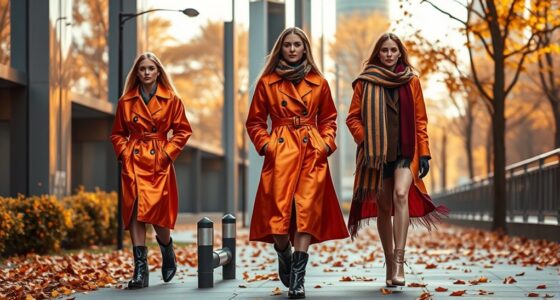Regenerative agriculture plays a vital role in sustainable fashion by improving soil health, which enhances crop growth with fewer chemicals and helps capture atmospheric CO₂. It supports ecosystem restoration, reduces reliance on synthetic inputs, and lowers pollution, making textile production more environmentally friendly. By choosing brands that embrace regenerative practices, you help promote resilient farms and climate benefits. Continue exploring how soil health and farming methods can shape a greener fashion future.
Key Takeaways
- Regenerative agriculture improves soil health, reducing chemical inputs and promoting sustainable fiber production for textiles.
- It enhances carbon sequestration, helping mitigate climate change impacts linked to the fashion supply chain.
- Healthy soils support resilient crops, ensuring stable supplies of natural fibers like cotton, hemp, and linen.
- By restoring ecosystems and reducing pollution, regenerative practices create environmentally healthier environments for garment production.
- Supporting regenerative agriculture encourages industry-wide adoption of sustainable practices, benefiting both the planet and fashion industry.

As the fashion industry seeks more sustainable solutions, regenerative agriculture emerges as a powerful approach that can transform how clothes are produced and valued. This method focuses on restoring and enhancing the health of the land, which directly benefits the fabrics and materials used in fashion. By prioritizing practices like cover cropping, crop rotation, and minimal tillage, you can support soil health—an essential component for sustainable textile production. Healthy soils act as natural carbon sinks, absorbing carbon dioxide from the atmosphere through a process called carbon sequestration. This not only reduces greenhouse gases but also improves soil fertility, enabling farmers to grow crops more efficiently and with fewer chemical inputs. When you choose fashion brands that utilize regenerative agriculture, you’re supporting systems that actively draw down carbon and build resilient land. This approach creates a positive feedback loop: healthier soils lead to more productive farms, which in turn produce higher-quality, longer-lasting fibers for your clothing.
By focusing on soil health, regenerative agriculture helps restore ecosystems that have been degraded by conventional farming practices. Instead of relying heavily on synthetic fertilizers and pesticides, regenerative methods foster diverse microbial life within the soil. This biological activity enhances nutrient cycling, making the land more fertile and resilient against droughts and pests. For you, this means garments derived from materials grown in such healthy environments are often more sustainable and less chemically intensive. Additionally, as soil health improves, the need for water, fertilizers, and other inputs decreases, lowering the environmental footprint of textile production. This makes regenerative agriculture a vital tool in reducing the fashion industry’s contribution to pollution and resource depletion.
Furthermore, soil carbon sequestration through regenerative practices helps mitigate climate change, which directly impacts global fashion supply chains. Extreme weather events, rising sea levels, and unpredictable growing seasons threaten the availability of natural fibers like cotton, hemp, and linen. Supporting regenerative agriculture means you’re promoting farming systems that can adapt to and withstand these changes. It’s a proactive way to ensure the durability of natural resources critical for textile production. As a conscious consumer or a responsible brand, understanding the importance of soil health and carbon sequestration helps you make informed choices. Whether you’re buying sustainable clothing or advocating for eco-friendly practices, recognizing the role of regenerative agriculture reinforces how interconnected the health of our planet and the fashion industry truly are.
Additionally, adopting regenerative practices in farming can improve the resilience of farmland against extreme weather events, ensuring a more stable supply chain for textile materials in the future.
Frequently Asked Questions
How Does Regenerative Agriculture Impact Water Conservation?
Regenerative agriculture improves water conservation by boosting soil health and water retention. When you support regenerative practices, you help create healthier soils that hold more water, reducing runoff and erosion. This means less water is needed for irrigation, conserving valuable resources. As a result, water availability increases for ecosystems and communities, making agriculture more resilient and sustainable while protecting our water supplies for the future.
What Are the Economic Benefits for Farmers Adopting Regenerative Practices?
You’ll find that adopting regenerative practices offers you financial incentives like grants and premium prices for sustainable products. These practices also promote market stability by enhancing soil health and crop resilience, reducing your dependence on expensive inputs and weather fluctuations. Over time, you can save money, increase your farm’s productivity, and secure a steadier income, making regenerative agriculture a smart economic choice for long-term success.
Can Regenerative Agriculture Be Scaled Globally for Fashion Supply Chains?
Scaling sustainable systems starts with spreading savvy strategies. You can see that regenerative agriculture can be scaled globally for fashion supply chains through strategic scaling techniques like collaborative certification, technological tools, and supportive policies. As more regions adopt these methods, the benefits grow, creating a cycle of sustainability. Global adoption depends on shared knowledge, innovative infrastructure, and committed communities, turning local practices into worldwide waves of positive change.
How Does Regenerative Farming Influence Biodiversity in Textile Crop Regions?
You’ll see that regenerative farming boosts biodiversity in textile crop regions by improving soil health and supporting pollinators. When you adopt practices like crop rotation and cover cropping, you help maintain rich, resilient soils that sustain diverse plant life. This, in turn, attracts pollinators like bees and butterflies, essential for healthy crop production. Ultimately, regenerative farming enhances biodiversity, creating a more balanced ecosystem that benefits both the environment and sustainable fashion initiatives.
What Are the Challenges in Transitioning to Regenerative Agriculture for Fashion Brands?
Moving to regenerative agriculture is like charting uncharted waters; you face hurdles like limited farmer education and complex supply chain coordination. You need to invest in educating farmers to cultivate new practices and align your supply chain to support sustainable methods. Overcoming these challenges demands patience and collaboration, but the rewards—healthier soils, vibrant ecosystems, and a more sustainable fashion industry—make the voyage worthwhile.
Conclusion
By embracing regenerative agriculture, you play a crucial role in transforming the fashion industry into a more sustainable one. Think about it—will you choose to support practices that heal the planet or continue contributing to its decline? Every purchase and choice can make a difference. When you opt for eco-friendly materials grown through regenerative methods, you’re helping to restore ecosystems and ensure a healthier future for fashion and the Earth alike. The question is, are you ready to make that change?









